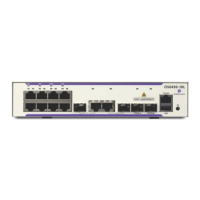OmniSwitch AOS Release 7 Network Configuration Guide March 2011 page 21-53
Note. MAC group configuration is not active until the qos apply command is entered.
To delete addresses from a MAC group, use no and the relevant address(es):
-> policy mac group macgrp2 no 08:00:20:00:00:00
This command specifies that MAC address 08:00:20:00:00:00 is deleted from macgrp2 at the next qos
apply.
To delete a MAC group, use the no form of the policy mac group command with the relevant MAC
group name. The group must not be associated with any policy condition. For example:
-> no policy mac group macgrp2
MAC group macgrp2 is deleted at the next qos apply. If macgrp2 is associated with a policy
condition, an error message displays instead:
ERROR: macgrp2 is being used by condition 'cond3'
In this case, remove the MAC group from the condition first; then enter the no policy mac group
command. For example:
-> policy condition cond3 no source mac group
-> no policy mac group macgrp2
The policy condition command removes the MAC group from the condition. See “Creating Policy Condi-
tions” on page 21-41 for more information about configuring policy conditions. The MAC group is
deleted at the next qos apply.
Creating Port Groups
Port groups are made up of slot and port number combinations. Note that there are many built-in port
groups, one for each slot on the switch. Built-in port groups are subdivided by slice. The built in groups
are named by slot (Slot01, Slot02, etc.). To view the built-in groups, use the show policy port group
command.
To create a port group, use the policy port group command. For example:
-> policy port group techpubs 2/1 3/1 3/2 3/3
The port group can then be associated with a condition through the policy condition command. Note that
the policy condition specifies whether the group must be used for source or destination. For example:
-> policy condition cond4 source port group techpubs
This command creates a condition called cond4 that can be used in a policy rule to classify traffic by
source port number. The port numbers are specified in the port group. For more information about config-
uring conditions, see “Creating Policy Conditions” on page 21-41.
Note. Port group configuration is not active until the qos apply command is entered.
To delete ports from a port group, use no and the relevant port number(s).
-> policy port group techpubs no 2/1

